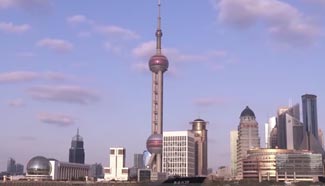HONG KONG, March 11 (Xinhua) -- Hong Kong will gain new growth momentum with the emergence of the "Guangdong-Hong Kong-Macao Greater Bay Area," an ambitious central government initiative aimed at boosting development of the Cantonese-speaking region in southern China, local scholars and economic analysts say.
In his annual government work report delivered last week, Premier Li Keqiang announced that the government will draw up a plan for the development of a city cluster in the Guangdong-Hong Kong-Macao Greater Bay Area, in a bid to give full play to the distinctive strengths of Kong Kong and Macao, and elevate their positions and roles in the country's economic development and opening up.
The idea of building a Greater Bay Area is not new. Most recently, the 13th Five-Year Plan (2016-2020), unveiled last year, pledged to facilitate the construction of the Guangdong-Hong Kong-Macao Greater Bay Area.
The Greater Bay Area is an updated version of the previous regional development initiatives, such as the Pearl River Delta and the Pan-Pearl River Delta, and it transcends regional divisions to highlight economic growth efficiency in the hub as a whole, said Andrew Fung, executive director of Hang Seng Bank.
The Greater Bay Area is a kind of natural, geological existence, which goes beyond administrative divisions, and it provides a vivid image, making it easier for policy makers to map growth strategies through comparing it with the world's leading bay areas, such as Los Angeles, New York and Tokyo, said Ma Xufei, head of the Center for Entrepreneurship of the Chinese University of Hong Kong.
The hub will mainly involve the Hong Kong Special Administrative Region, the Macao Special Administrative Region, and nine cities in Guangdong, namely Guangzhou, Shenzhen, Zhuhai, Foshan, Zhongshan, Dongguan, Huizhou, Jiangmen and Zhaoqing.
Analysts believe Hong Kong can seek new growth momentum in the collaborative dynamics in the proposed hub.
Ma believed Shanghai has succeeded as a financial center through integrating with the Yangtze River Delta, a key manufacturing center in eastern China, linking its financial services with the real economy.
Another key manufacturing center, the Pearl River Delta in southern China, is within the reach of Hong Kong, Ma said, explaining that Hong Kong's manufacturing chain is incomplete and its own market is small, but the weaknesses can be overcome through joining hands with the Pearl River Delta, which boasts a complete manufacturing chain and a large market.
Analysts believe the initiative will enable the cities included to further boost their strengths and complement each other in collaboration.
Hong Kong has advanced financial services and other professional services such as accounting, auditing, and project management, while demand for such services is huge in the inland, which is upgrading its manufacturing sector, Ma said.
The Hong Kong Special Administrative Region is endowed with standard market system, mature legal system, advanced infrastructure equipment and relatively low tax rates, which will enable it to remain competitive in the coming years, said Ye Bingnan, an analyst with Bank of China International.
Hong Kong is well-placed in the finance and services sectors, Shenzhen is good at innovative technology, and Guangzhou boasts leading colleges and research institutes, Ye said, noting different cities will build on their strengths in collaboration.
Foundation for such a proposed hub is solid.
The region shares similar folk culture and Cantonese dialect, which allows space for cultural and creative industries, said Witman Hung, president of Hong Kong's Internet Professional Association.
The Hong Kong-Zhuhai-Macao Bridge, which is expected to complete construction by the end of this year, will cut the driving time remarkably between Hong Kong, Guangzhou, Zhuhai and Macao, and this is an impetus to greater integration of the region in the proposed hub, Hung said.
The Greater Bay Area involves more than 66 million urban residents and about 1.3 trillion U.S. dollars of GDP. The Greater Bay Area is quite promising and Hong Kong will make full use of its own unique competitive edges to cooperate with other cities, said a written response to Xinhua by the Constitutional and Mainland Affairs Bureau under the Government of the Hong Kong Special Administrative Region.
The involved local authorities can join hands to build coordinated business environment to attract more enterprises to take part in forging the proposed hub in an active way, Ye added.













